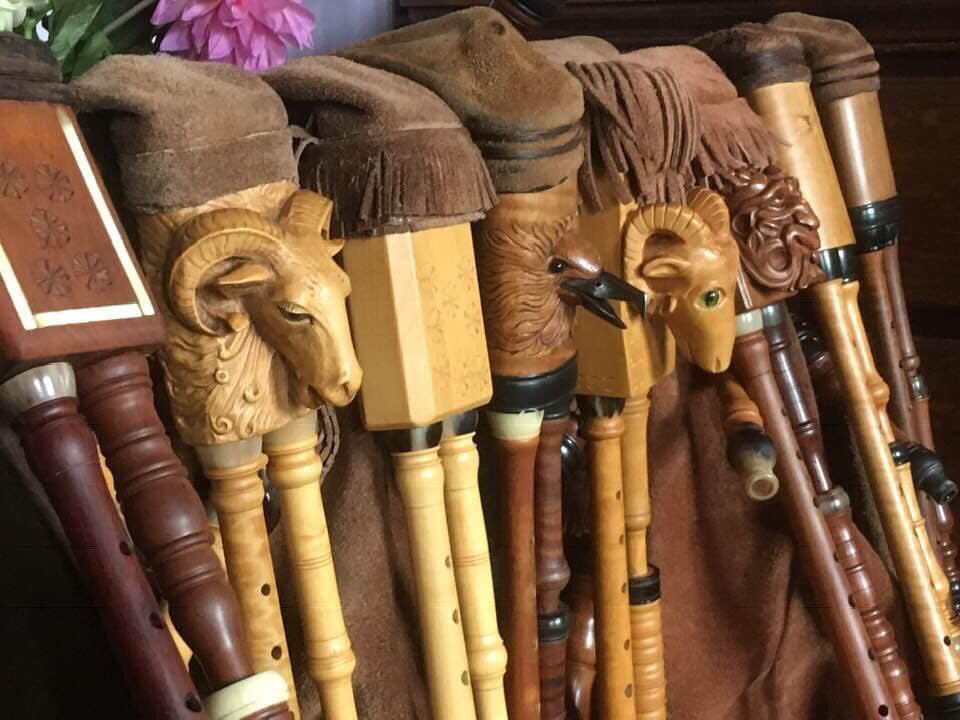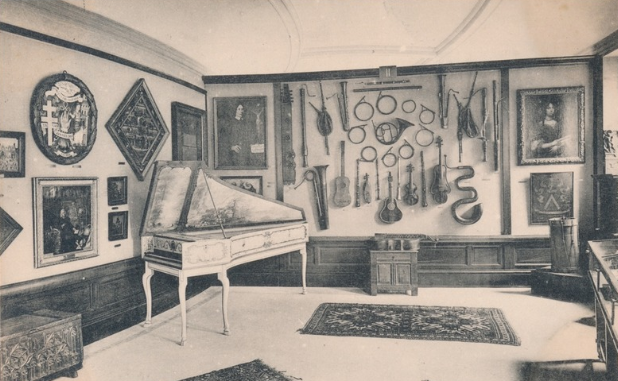The Muzelzak – Muchosá
Ever since the revival of folk music started in Belgium, around 1965, and an "own" bagpipe emerged alongside the rumble pots, hurdy gurdies and Lichtervelde accordions, we are troubled with the identity of the instrument. Still, our bagpipers are teased with lame jokes about wearing a kilt and whether or not to have underwear. And even, when players are approached by people showing genuine interest, the reference to the Celtic tradition still prevails and the conversation is introduced by their experiences of Scotland or Ireland.
Let me first point out that in Dutch we use the term doedelzak as a general collective term for all wind instruments with a bag and several pipes, with single or double reeds. The actual dutch word doedelzak is in fact a loanword from German. The word dudelsack, also replaced the older sackpfeife there. The word became popular at the time when many Polish street musicians were active with their dudies. Before that, we usually spoke of muzelzak, moezelpype or cornamuse, all coming from Latin musa, but also the word quene is used occasionally. These names could indicate different types in use at the time in our regions, but it is not certain that this happened consequently, rather they were synonyms. On the town account of the Ommegang at Dendermonde of 1470, we see that 2 pounds and 16 gros sous were paid out, divided among 56 musicians, including "cornenmuesen". At previous editions, the city of Dendermonde had made an appeal to attract musicians to the feast. This success was surpassed in 1477, out of a total of 72 musicians we see a participation of 28 moezelpypers. The account of 1522 mentions quenen and mouselen. Moreover, all the musicians are mentioned there by name.
In this article, I want to talk about the Muzelzak or Muchosá, the smaller type. This was launched in the Belgian Folk World in the 1970s, partly because of the attention the Hainaut museum pieces received, but as folk evolved and folk instruments such as the hurdy-gurdy and the diatonic accordion became more popular, the Muzelzak was considered less practical and a bit forgotten because of its key in B flat. People started looking for an instrument with a key that could be used in ensemble playing. A bagpipe in G-C was developed by two instrument makers, Remy Dubois from Verviers in Belgium and Bernard Blanc from Vichy, France. For the French market, the new instrument was given the appearance of the French Cornemuse du Centre, with the small drone along the chanter and one drone on the shoulder; for the Flemish market, the model we know from paintings by Brueghel and his contemporaries was chosen. We call it Flemish bagpipe, Brueghel bagpipe or Renaissance bagpipe. No physical old examples of this model are preserved. So one has to rely on paintings to recreate these instruments. This model became more popular from the 1980s onwards. However, the smaller muzelzak has an important advantage in terms of authenticity: We have in fact in the Brussels Museum of Musical Instruments (MIM) three copies that have been measured exactly, which makes the historical background of the copies more relevant. Lately, the muchosá or muzelzak is being mentioned more often again. It is loved for its characteristic timbre. It is also extremely suitable for playing in marching bands.
Shepherds also played together in polyphony during their village festivals and pilgrimages. Yet it remains difficult today to convince players in our country to choose this instrument. Around 2000, the Galician gaita briefly became very popular with us with a number of followers. But especially the commemoration of 100 years of World War I from 2014 to 2018 has just brought Scottish bagpipes back into the spotlight, and new pipe bands have been formed in several places in our country.
But, we are going to talk about this particular small bagpipe, first described in the 17th century and given its own regional name depending on the region where it was played. In France, we speak of pipasseau (Picardy), or piposá (French Flanders and Artois), and in Belgium, of muchosá (Picardie Wallonne), and muzelzak (West, East, and Zeelandic Flanders).
Marin Mersenne
The Muzelzak is first described by Marin Mersenne in his Harmonie Universelle, published in 1636. The instrument is described in detail with the name cornemuse rurale des bergers with accompanying drawing. He distinguishes this instrument from other types of bagpipes he further describes, such as the Musette, the Italian Sourdeline and the Cornemuse de Poitou. On his drawing, Mersenne shows a mouth-blown instrument with a small drone next to the chanter and a large drone, which is held up on the shoulder. The chanter can be shortened by taking off the bell. The configuration is thus the same as that of our muzelzak or muchosá.
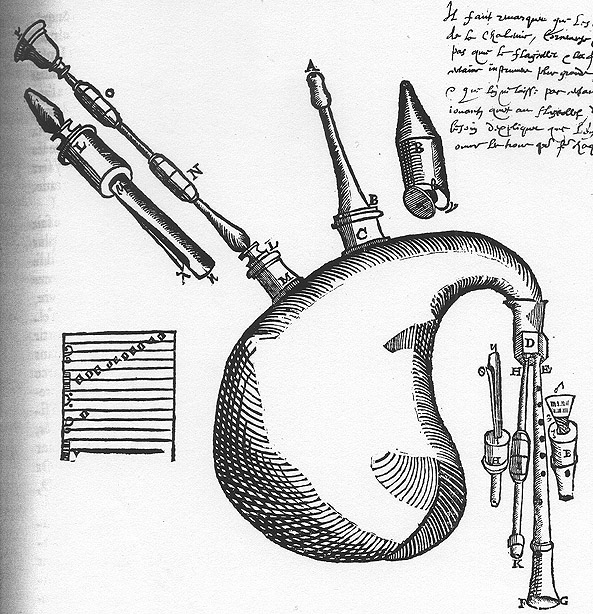
There are several French types known with a small drone next to the chanter such as the chabrette du Limousin, but of the chabrette the large drone is held sideways on the left forearm. Also the cabrette from Auvergnes and the types cornemuse du Centre, have a little drone sideways the chanter but these too differ just a little too much from the type described by Mersenne. The cabrette's small drone, is called chanterelle, and features a double reed instead of a single reed. In the Spanish Pyrenees, we have the Aragonese gaita de boto with also a small drone next to the chanter, but here too, the structural characteristics make it a different type of bagpipe. For the length of the chanter of the cornemuse des bergers, Mersenne gives ‘13 pouces’, 13 inches. This corresponds to the length of our muchosá in B flat. As for the geographical distribution of the instrument, Marin Mersenne leaves the reader in the dark But based on the detailed description, we can assume that it is about the same instrument that we know in Belgium as muchosá or muzelzak and pipasseau or piposá in northern France.
Joost Verschuere Reynvaan
In 1795, the Muzykaal Kunstwoordenboek by Zeeland musicologist Joost Verschuere Reynvaan was published. In it, the name muzelzak is mentioned for the first time. The instrument is described in detail and the accompanying drawing concerns a bagpipe completely similar in shape and turnings to the Hainaut muchosas preserved in the Brussels Musical Instruments Museum (MIM).
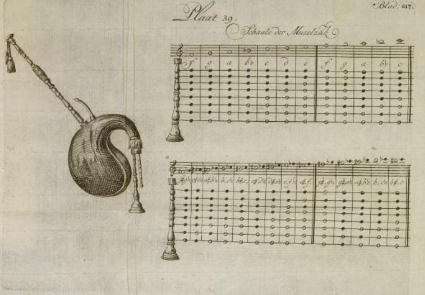
Joost Verschuere Reynvaan describes in detail how the instrument works, giving a scale indicating that the instrument was in G-C, so with G as the root note and an F for the right hand little finger. Different, then, from what Mersenne specifies, for a chanter a length of 13 inches we think of the key as B flat. Is Verschuere Reynvaan giving a tonal scale here that could apply to several types of bagpipes? Possibly, many players used models in multiple keys and considered G to be the root note for every bagpipe they played, regardless of tuning. Just as today the clarinet player reads a do on the score, for a sounding B flat. Reynvaan describes two types of bagpipe, the Muzelzak and the Cornamuse, better known today as the Brueghel bagpipe. He makes a clear distinction, the Cornamuse has two pipes at the top, sometimes three and only one at the bottom. The muzelzak has only one pipe pointing upward, the large drone, which he calls the ‘grove roenker’. And below, two pipes, namely the chanter with seven finger holes and a thumb hole, with the small drone next to it. He also names the blowstick as the wind pipe, which is fitted with a valve. And he gives instructions on how to maintain the leather bag.
La Cornemuse Petyt
At the MUPOP museum in Montluçon, central France, there is a boxwood bagpipe that looks very much like our muzelzak. It matches the descriptions of Marin Mersenne and Joost Verschuere Reynvaan. The stock that holds the chanter and the small drone together bears a sculpted image of a bagpiper in 18th-century clogue. The finger holes on the chanter are all drilled with the same diameter drill and at equal distances between, exactly like the 3 muchosás in the Brussels Museum of Musical Instruments (MIM). The copy by Remy Dubois is tuned between a modern A and B flat, just a little bit lower than our own muchosás. It is still a guess where the instrument came from.

It was purchased at the ‘Marché au Puces’ in Paris in the late 1970s by later antique dealer and musical instrument expert Jean-Michel Rénard. The market vendor was also unable to tell where the instrument came from. More than likely, it is a Cornemuse Picarde , a Pipasseau from the Amiens region or a Piposá from the Béthune - Boulogne region. On both sides of the carved stock, there are inscriptions in bas-relief referring to the instrument maker and to the owner. One side reads FESIT PER ME (made by me) YOANNES STEPHANE PETYT and the other side APPARTIEN A (owned by) CHARLES PETIT # # 1782 # . That Charles Petit spelt his surname differently from the builder Stephane Petyt is a little bizarre, yet it seems obvious that Petyt and Petit were not necessarily two different families. The builder and the later owner may have been very closely related. Petyt was, in the 18th and 19th centuries, a surname that occurred almost exclusively in northern France and West Flanders. But all indications are that this is a French instrument. The back of the block is carved in the shape of two parallel cylinders and is somewhat reminiscent of a Parisian style like some models by bagpipe maker P. Gaillard. The block is additionally richly decorated with butterfly bows, also in bas-relief, but these clearly show scratch marks indicating that the butterflies were actually originally lily motifs and were probably hastily updated into bows after the French Revolution, as the 'Fleur de Lys' was a reminder of the expelled French royalty.
Shepherd's Matins in Artois at Christmas time
A very picturesque and ancient custom was still in vogue at the beginning of the 19th century in Valhuon, a village in the North of France. At Christmas, during the midnight mass, when the time for the offering had arrived, the officiating priest, holding his paten, descended the steps of the altar and approached the balustrade in front of those present. Towards the ends of the balustrade, were two young men, each carrying a long branch of holly. At that very moment, the sound of the bagpipes, the piposó, as this musical instrument is called in the local dialect, was heard in the packed church, and a shepherd dressed in his usual costume, with a heavy sheepskin coat called ‘plu’ and a large felt hat, and holding in his hand his staff, to the top of which was attached a cake, was seen to be advancing towards the priest. This shepherd was followed by an individual, dressed in white from head to feet, with a white face, who was leading a beautiful lamb that bleated and resisted with all its legs not to follow him. Then came the shepherds from the whole region. When they arrived in front of the priest, each of them knelt down and kissed devoutly the paten which was presented to him. In turn, the shepherd offered his cake. But when the children of the choir put their hands forward to take it, he pushed it aside so that they could not take it, and this game lasted for a while, to the great joy of the audience. At the end, the cakes were all passed to the priest, and the shepherds left, playing on their bagpipes the occasional tune, which unfortunately has not been collected and is now lost.
People liked to see the shepherds of Diéval arrive, whose outfit was magnificent: a large hat decorated with ribbons, white gaiters, fixed below the knees with pretty red and green bows, a helmet and breeches of hazelnut-coloured fabric. These shepherds walked majestically forward playing the most beautiful pastoral melodies. In Valhuon, the Shepherds' Matins took place for the last time on 24 December 1807. It is believed that the Matins did not end in Sombrin until 1830. But they existed in other places in the Artois and were, there, longer in honour. In Wierre-au-Bois, a kilometre from Samer, this custom was still practised in 1870. The shepherds from the neighbouring farms and villages, dressed in their sheepskin coats and their large waxed hats on their heads, came to midnight mass, each followed by a lamb and a dog, blowing their bagpipes. When mass was over, they would go together to the Christmas manger and there they would play local Christmas songs, including the one that is still sung everywhere today: "Il est né le divin Enfant".
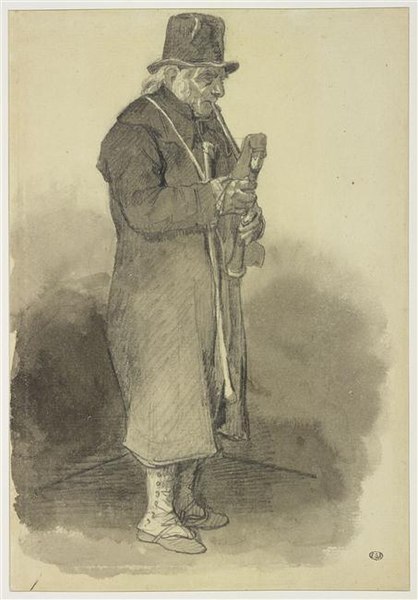
The Piposá’s of Rébreuve-Ranchicourt
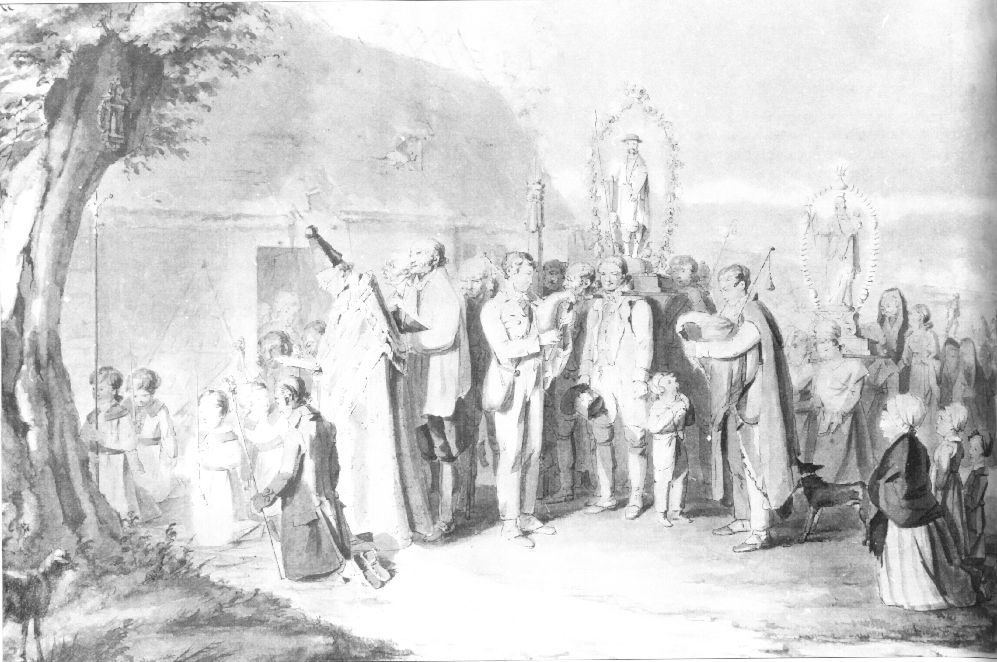
During the restoration works of the Earl's Castle of Ranchicourt in 1995, one finds in a folder of drawings, a work from 1823, entitled 'Procession for Saint-Druon, patron saint of shepherds'. We see the polychromed statue of Saint-Druon, carried on shoulders, and further on, a statue of Saint-Mary with child. In the foreground, two bagpipers.
The instruments are painted with a few brushstrokes, yet we clearly recognise the details we know from the muzelzak type. The scene is set in northern France near Béthune, where this shepherd's instrument was known as piposá. In the corner of the painting is written Ph. d. R. 1823. These initials refere to Philibert d'Amiens, Count of Ranchicourt, 1781 - 1825. He lived in the Castle at Rébreuve-Ranchicourt in Artois, of which a barn is in the painting. This find is very important. It is the first time iconographic evidence has surfaced of an existing bagpipe tradition in northern France. Until then, the piposá had only been mentioned now and again in archival texts. It was also linked to the worship of Saint-Druon by shepherds in this region, a cult that was also particularly strong in Belgium represented by the Confrérie de Saint-Druon. It is conjecture whether Artois shepherds had contact with Hainaut shepherds, but it is not impossible. Shepherds were used to moving over long distances. Philibert d'Amiens, besides his noble besognes, was a prolific painter. He won a number of medals with his works, including at Douai. Other works by him can be found on auction sites. Unfortunately, the trace around the work with processional scene has been lost after the restoration works of the castle. The statue of Saint-Druon, which was still in the castle before the works, is said to be under restoration at the moment.
The Lobidel Stock
In Paris, at the Musée des Arts et Traditions Populaires, there is a wooden block with a carved face. There are two cylindrically drilled holes and the piece of goatskin leather, tied to the block, is cut off from what was once a bagpipe. The artefact is a double stock, meant to hold together a chanter and a small drone, and was attached to a goatskin leather bag. Nothing is known of its provenance, but, carved parts of a bagpipe rather point towards Flanders and northern France. Moreover, it has a name carved into it, Lobidel. Research on this surname isolates a very small distribution area in the Bruay-en-Artois area.
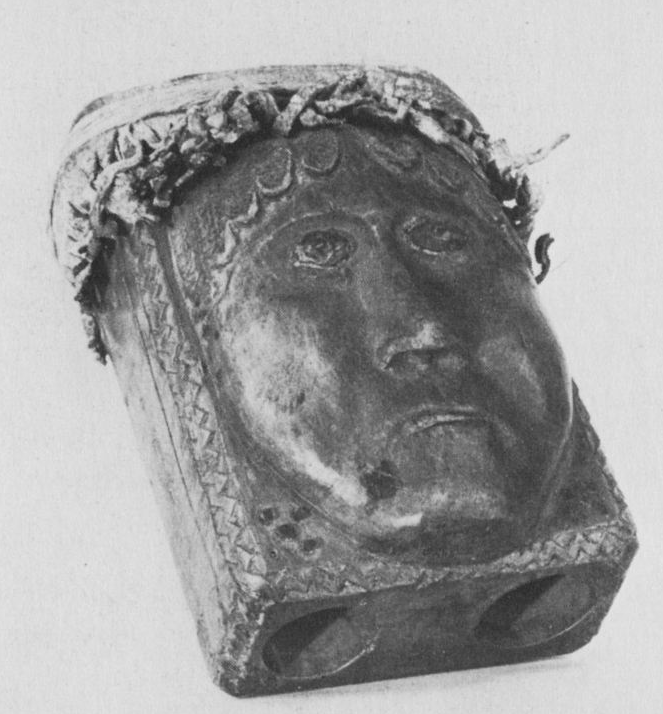
This brings us very close to these two pipers, who played during the procession in Ranchicourt, barely 7 km. There is a possibility that Lobidel was one of the players depicted on Philibert d'Amiens' canvas, or at least an acquaintance of them.
Saint-Drogo of Sébourg (Saint-Druon) Épinoy 1102 – Sébourg 1186
Saint Drogo was a hermit of Flemish noble descent. At birth, his mother died. When he learnt this at the age of 10, it hit him very hard. He also lost his father at an early age. As an 18-year-old, Drogo distributed his possessions to the poor and, according to his hagiography, he made twelve pilgrimages to Rome before the age of 30. Drogo made the pilgrimages to do penance. Finding the penance too light, he put peas in his shoes. Drogo suffered a hideous disfigurement during his pilgrimages. He was a shepherd for six years in the service of Elisabeth de la Haire in the region of Sebourg, near Valenciennes. Then he became a hermit, forced by a hernia that disabled him, and he would not leave his cell or hermitage for the rest of his life, even when the wooden, thatched church was on fire. The vault stood against the church wall and was nailed up. Only a narrow slit left open allowed the hermit to see light and receive the essentials. According to tradition, he survived the last forty years of his life solely on water, barley and the Eucharist. Even as a shepherd, Drogo was already renowned for his pious way of life. According to hagiography, he possessed the gift of bilocation, the ability attributed to saints to be present in two places at the same time. According to tradition, he was seen by witnesses while working in the fields and at Mass at the same time. The first miracle attributed to Drogo is that it proved impossible to bring away his family-claimed dead body from Sebourg. One failed to pull the cart with his corpse up the hill. Thus, the saint expressed his desire to remain in Sebourg. A stone cross was erected where the journey ended and still stands today. St Drogo's feast day is 16 April.
Pierre-François Muselet, (1835-1915) piposá player near Boulogne
I got to know Patrice Gilbert as a hurdy-gurdy player when we went dancing every month in Lille with a delegation from Bruges in the early 1980s. A musician of the Folk revival and a loyal visitor to festivals where hurdy-gurdy and bagpipes made their timid appearance, he only found out years later that among his ancestors, he had a traditional bagpiper. His great-great-grandfather on his mother's side, Pierre François Muselet, turned out to have been active as a shepherd in the Boulogne area at the time, around 1860, and as befitted a shepherd of the time, he also played the bagpipes, piposá, as Patrice's great-aunt remembered it. His grandfather, on the other hand, called it a biniou. This Breton term has recently become more widely used in French to refer to bagpipes. The instrument itself has disappeared but stories in Patrice's family confirm the practice of the piposá in the Boulonnais and its connection to the pastoral profession. Pierre-François Muselet was born in Equihen (then Outreau) on 23 November 1835. During his lifetime, he practised many trades, not consecutively, but simultaneously, depending on the season and the occasion. He was a shepherd on a farm with sheep near the junction between Outreau and Le Portel. He could also shear sheep and offered his services on many farms, as far as the Liane. One day, on his way back from shearing, he even fell into the river. This anecdote was told in a sober tone that suggested our shepherd was not entirely sober. His main profession was shoemaker and he offered his services everywhere. He could also reupholster chairs and occasionally, in winter, went out to sea to fish herring. During 35 of the last years of his life, he also worked as a gravedigger. During the time he was a shepherd, he played piposá. One of the things he did was play during midnight mass with other shepherds. This must have been around 1860, the time he was a shepherd. In a tobacco shop-café on the Place d'Equihen, run by a certain Fourquet, Pierre-François Muselet would often go and play in exchange for a drink. This was not appreciated by his wife, so much so that one day, she got fed up with these drunks and pierced the pocket of his bagpipe so that the café visits would stop. She made him believe it had been a mouse that had made the hole. As a shoemaker, he could have repaired the leather sack, but he chose to stop playing to keep the peace.
Le Berger Leuzois, Agé de 118 ans
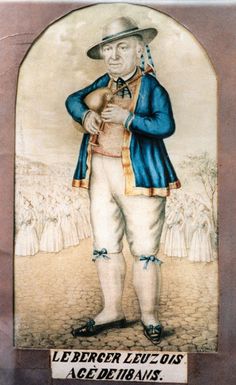
In Leuze-en-Hainaut, a few decades ago, this lithograph from 1830 turned up at a photographer’s shop. We see a man, in his fifties, with an instrument that looks like a muzelzak, as already described above. The inscription Le Berger Leuzois, Agé de 118 ans was added later, at least after 1885. It is said to refer to shepherd François Henniquiau. The shepherd had his sheephold at Pipaix, borough of Leuze-en-Hainaut. Hubert Boone mentions in his book Doedelzaktraditie in België that Henniquiau is said to be of Breton origin. that might not be quite correct. Searching for the name in genealogical internet sites, we find this surname only in a very small area around Leuze and Ath, and a few more in northern France, but not at all in Brittany. The confusion is more on the name of the instrument. Although in the Leuze-Ath region the muzelzak was known by the Walloon-Picardian name muchosá or muchafou, the instrument is very often named by the Breton word biniou, which is the commonly known alternate word, other than ‘cornemuse’ for bagpipe throughout the French language area.
According to the same genealogical internet sites, shepherd François Henniquiau is said to have been born in 1780. The lithograph is associated with the millennium celebration of Canon Saint-Badilon in 1885. Possibly the shepherd was still alive then. Whether he would have lived another 13 years after that, until 118, as the inscription would have us believe, is unlikely. Nevertheless, Noel Demey from Bruges in his blogspot Belgian Super Centenarians mentions a shepherd in the Luxembourg Ardennes, Hubert Fairon, who attended another meeting of shepherds at the age of 118. He died aged 120. A healthy profession, clearly.
Pierre-François Muselet, (1835-1915) piposá player near Boulogne
I got to know Patrice Gilbert as a hurdy-gurdy player when we went dancing every month in Lille with a delegation from Bruges in the early 1980s. A musician of the Folk revival and a loyal visitor to festivals where hurdy-gurdy and bagpipes made their timid appearance, he only found out years later that among his ancestors, he had a traditional bagpiper. His great-great-grandfather on his mother's side, Pierre François Muselet, turned out to have been active as a shepherd in the Boulogne area at the time, around 1860, and as befitted a shepherd of the time, he also played the bagpipes, piposá, as Patrice's great-aunt remembered it. His grandfather, on the other hand, called it a biniou. This Breton term has recently become more widely used in French to refer to bagpipes. The instrument itself has disappeared but stories in Patrice's family confirm the practice of the piposá in the Boulonnais and its connection with the pastoral profession. Pierre-François Muselet was born in Equihen (then Outreau) on 23 November 1835. During his lifetime, he practised many trades, not consecutively, but simultaneously, depending on the season and the occasion. He was a shepherd on a farm with sheep near the junction between Outreau and Le Portel. He could also shear sheep and offered his services on many farms, as far as the river Liane. One day, on his way back from shearing, he even fell into the river. This anecdote was told in a sober tone that suggested our shepherd was not entirely sober himself. His main profession was shoemaker and he offered his services anywhere. He could also reupholster chairs and occasionally, in winter, went out to sea to fish herring. During 35 of the last years of his life, he also worked as a gravedigger. During the time he was a shepherd, he played piposá. One of the things he did was play during midnight mass with other shepherds. This must have been around 1860, during the time he was a shepherd. In a tobacco shop-café on the Place d'Equihen, run by a certain Fourquet, Pierre-François Muselet would often go and play games in exchange for a drink. This was not appreciated by his wife, so much so that one day, she got fed up with these drunks and pierced the pocket of his bagpipe so that the café visits would stop. She made him believe it had been a mouse that had made the hole. As a shoemaker, he could have repaired the leather sack, but he chose to stop playing to keep house peace.
The Muchards of Northern Hainaut
Until World War I, most of the villages on the Walloon banks of the Scheldt, and in the Pays des Collines, still had musical bag players, muchards. They were mostly shepherds, but also artisans and cattle breeders. Most of them were members of the Confrérie des Muchards, a bagpipe guild, say, probably part of the Confrérie de Saint-Druon, which was then specifically aimed at shepherds with Saint-Druon as their patron saint. As a compact bagpipe, the Muzelzak was ideally suited for the shepherd to pass the time while the sheep were grazing. A 19th century handbook for shepherds also very strongly recommends the prospective shepherd to play a musical instrument, preferably, shawm or bagpipe. It keeps the sheep calm and it serves as a beacon for the sheep, so they always know where the shepherd is. This is in contrast to Swiss cow herders, the cows themselves have bells so the herder know where they are. But besides the use of the muzelzak on the grazing pasture, the instrument was also frequently used to brighten up village festivities, which is why with Léonie Devos from Arc-Ainières, of the four melodies she could still remember, two Polkas and a Round Dance were recorded. She remembered those dance melodies from her 16th birthday in 1899, when innkeeper and cattle breeder Fréderic Mortier from Mourcourt played for her. The fourth melody was a Pilgrimage March and this one came from the repertoire played by the muchards during their pilgrimages to Oostakker and Bon-Secours. That there were more players could be inferred from the story of Josephine Piron. She was the daughter of Thomas Piron and niece of his brother François Piron. Both played muchosá; in fact, it was their instruments that were later bought by notary César Snoeck from Ronse, an avid instrument collector. His collection was split up after his death and went to museums in Berlin, Petersburg and Brussels. The two muchosás are in the MIM's collection. According to Josephine Piron, the pilgrimage to Bon-Secours left very early in the morning at the chapel of Saint-Druon on the heights of Hoguenne near Saint-Sauveur accompanied by some three muchosas. The group of pilgrims grew along the way and the delegation that joined in Velaines included at least another three muchards. They played with several together while stepping and also polyphonically. It was these muchards from Velaines who played best at the annually organised competition. There was also an annual pilgrimage to Oostakker, near Gent, which was also usually accompanied by three muchards.
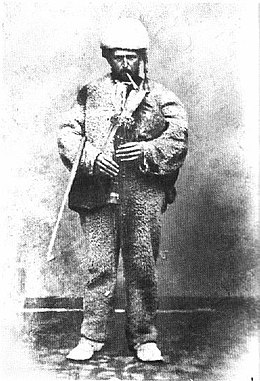
Another fixture for the muchards was the Fiertel, the annual circumambulation on Trinity Sunday in honour of Saint-Hermes. The Ronsen people, who considered a pilgrimage to their own city too meagre a penance, had the opportunity to do penance anyway with this 35-km walk around the city. The tradition is still organised every year and ends with a procession in the town of Ronse. In 1885, during the Fiertel, shepherd Alphonse Gheux had his picture taken with his instrument in hand and all dressed in sheepskin. Alphonse Gheux was one of the last players, he played until 1912, until his muzelzak broke and the remains of the irreparable instrument disappeared into the bread oven.
The search for the third Musochá
In 1968, Hubert Boone, as a new employee at the Instruments Museum in Brussels (MIM), began cataloguing a very varied collection of folk music instruments. Much of it was a donation from the Snoeck family of Ronse. Notary César Snoeck had been an avid collector of musical instruments. Two of the most curious pieces in this collection were bagpipes, which seemed exotic at first sight. Hubert Boone was therefore particularly surprised when it turned out that these instruments turned out to be of Belgian origin, originating from the village of Arc-Ainières, in the province of Hainaut. He decided, at his own expense, to investigate the matter closely. Over several Saturdays, he takes his bicycle on the train to go and scout the region. He talks to older villagers, who were young when bagpipes were still played there.
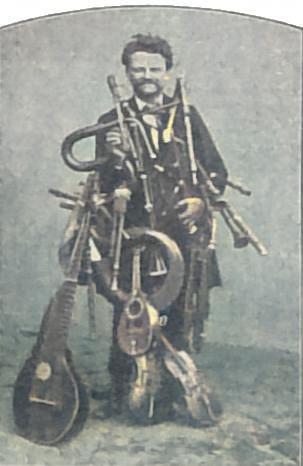
Hubert Boone asked about the Piron brothers, who were once the owners and players of the two instruments, later collected by Notary Snoeck and today in the MIM in Brussels. It is Josephine Piron, the daughter of Thomas Piron, who speaks to him about Georges Gheux. Georges, she says, still played the bagpipes of his father, Alphonse Gheux, in his youth. Hubert goes to the Gheux family and they show him a photo of Alphonse, Georges' father, with his Muchosá. He is also told of one Charles Louis Lehon, a fellow shepherd of Alphonse, who lived in Popuelles. His eldest son had also started playing his father's instrument at the time. The instrument was bound to be found with Marcel, Charles-Louis' grandson, they said. Hubert Boone went in search of this grandson, who turned out to live in Escanaffles. Unfortunately, it was already late that Saturday, and Hubert had to hurry to catch the last train. A long time passes before he is able to revisit the region. He starts copying the Piron brothers' bagpipes, which are in the MIM. Soon he starts using them in his Folk Music Group ' De Vlier' and he makes some recordings with them. Meanwhile, the results of his research were published and came to the attention of the Musée de la Vie Wallonne, which promptly launched a survey on the existence of the bagpipe in Wallonia. This survey hardly finds resonance in the region, except with the constable of Mourcourt, Mr Boucart. He does take the survey very seriously and goes to investigate Charles Louis Lehon's bagpipes. He finds the instrument at the shepherd's grandson, Marcel Lehon, at Escanaffles.He takes photographs of it, although he does not know enough about musical instruments to correctly assemble the individual pieces of the bagpipes. Indeed, some holders of drone and blow-in pipe were missing and the bag was also missing. The forester tries to convince the shepherd to hand over the instrument to the Musée de la Vie Wallonne in Liège. Marcel pertinently refuses. After all, he remembers very well that the same policeman, Boucart, had fined him for not mowing the thistles in his field in time.
Finally, a third researcher hits the trail to the bagpipes. It is Remy Dubois, today one of the most respected makers of bagpipes. He lives in Verviers, but his family is actually from Kain, near Tournai. In conversation with Marcel Lehon, he mentions his grandfather at Kain and Marcel is proud to have known him as a teacher in his youth. It was getting late, that day, and it was already a little too dark to take good pictures. Remy asked if he could take the instrument with him to take decent studio photos, to which Marcel replied, " Puisque tu es de la région, tu peux l'avoir ". Just in time, the instrument had always been kept in the drawer of a Picard-style cabinet, which he had planned to sell the following week to his cousin, who had a bric-a-brac shop in France. Possibly, Popuelles' bagpipe had remained in it for sale and would thus have found its way, or its end, in France. The instrument was later transferred to the MIM in Brussels.
The double holder for chanter and small drone is decorated with a ram's head and the large drone is decorated with carvings depicting a shepherd with sheep and dog, the inscription SAINT DRUON A SBOURG NÉ A CALVAIN PINOI and the chapel of Moustier, near Frasnes-lez-Anvaing. At the bottom of the drone are further notches, FAPxNART A MOUSTIER. As usual, this is probably the builder: Frabriqué par Nart à Moustier.
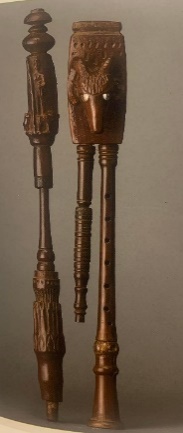
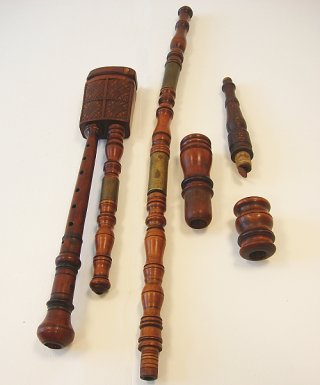
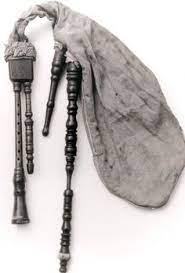
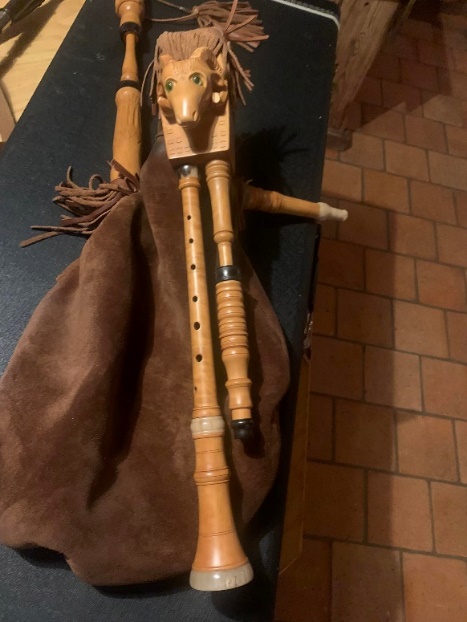
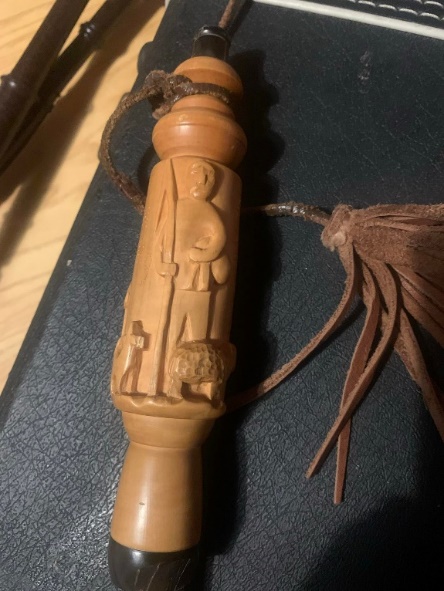
A Cornamuse à la David Teniers or a Muzelzak in Bruges, 1909?
In the book Doedelzaktraditie in Belgium, I first saw a postcard from 1909 with a black and white image of a blind Bagpiper in a market scene, probably in Bruges. The work is called Au pays Flamand, l'Aveugle.
Why do I think of Bruges? The painter from Lille in northern France, Georges Hippolythe Dilly, (Lille 1874 - Châtel-Guyon 1941) had in-laws living in the Bruges area. Many paintings by his hand are images of the Bruges city centre, De Reien, Churches, belfries and rows of houses, the Beguinage, he painted it all several times. There is one painting with a blind bagpiper, the setting is a bit vague, but as is often the case with art painters, the musical instruments are depicted in great detail. There is no immediate marketplace in Bruges with a row of houses thus recognisable and a plump church tower in the background.
But this row of houses does exist and Dilly had already painted it once, also in 1909, the work is called Les Vieilles Lucarnes de la Ruelle and it concerns the Lange Raamstraat, with the Saint-Gilles church tower in the background, depicted in this work not plump but sharp. The young lady looking back at the blind man can also be seen in another painting by Dilly. There she sits on a flat boat on the canals, shoulder to shoulder with a young man playing a Lichterveld accordion. So the market scene could have been inspired by an existing Bruges market square, with a different row of houses. Looking now at the blind man's instrument in detail, we see two parallel drones, on the shoulder. The leather pouch under the right arm, that's already not what we expect, but we don't see a blow-in pipe, though a leather strap on the back. Possibly the blind man was playing with a bellows. Below the right hand we see a ring, metal or horn, possibly the ring of the sound cup. Or it could be the lower ring of a small drone, next to the chanter, as of the muzelzak. We would also expect that small drone on the left, but the leather bag was also on the right, it is actually possible. That would then be an instrument with three drones.
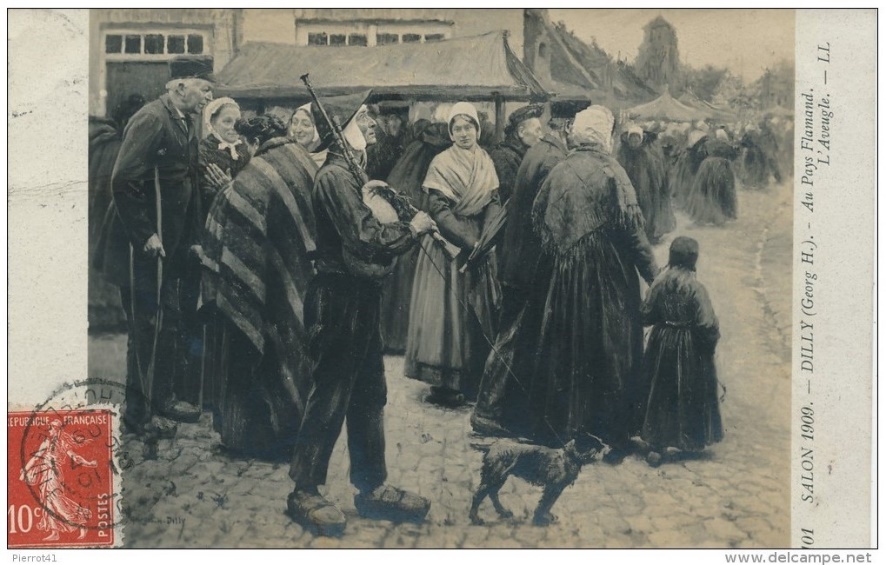
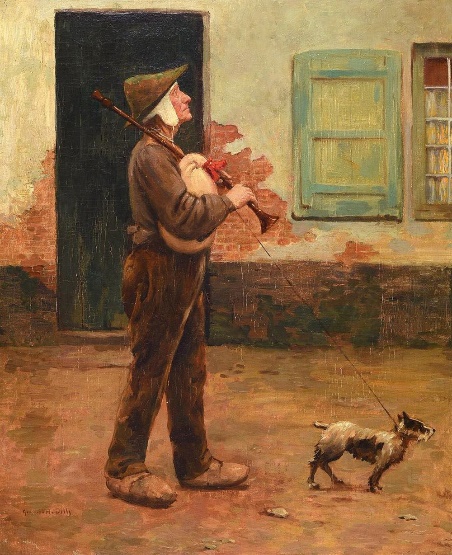
More clarity came when another painting by Dilly surfaced on an Internet art auction site in October 2022, showing the same blind player in a rural village setting. The work was sold in August 2021 and cannot be traced for now. But this painting clearly shows only a single drone on the shoulder, and the spot under the left hand betrays even more than in the market scene, a ring of a small drone next to the chanter, so here it does clearly show a muzelzak, which apart from the bellows, fulfils the characteristics put forward by Marin Mersenne and Joost Verschuere Reynvaan. My idea is that this latest discovered work by Dilly is older. The work Au Pays Flamand, l'Aveugle is a more sharply finished painting. The setting may be vague, but the characters and musical instrument are rendered in great detail. He has already used most of the elements in earlier paintings. As the work was destined to participate in the Salon de Paris in 1909 as part of his Au Pays Flamand series, he enriched the blind man's instrument with a second drone on the shoulder. No doubt he had seen this in old Flemish masters such as Jordaens and Teniers and thus wanted to make the instrument look more Flemish. If this is correct, then we can assume, judging from the dimensions and structural details of the bagpipe in the oldest painting, that the blind man was actually playing on a muzelzak. That on this work we also suspect a bellows instead of a mouth-blown instrument need not be a problem. Indeed, the blind man may have been forced, say, by defective teeth, to adjust his muzelzak. It was, after all, about his livelihood.
Two blind muzelzakplayers in Bruges
On the Internet site Erfgoed Brugge, Bruges Heritage, while searching for the facts surrounding Dilly's work, I found, among other things, a story from 1883 about two Bruges blind bagpipers. It is about Anselmus and Blind Cent, who were able to make a living with their bagpipes. They played in markets and squares for the hat, they were asked for parties and they were welcome in Bruges pubs to play music. They were very well matched and had quite a bit of success. One of the pubs where they regularly played was Herberg Den Engel, in Loppemstraat near Simon Stevinplaats. The story goes that their close friendship was put to the test by a rich man who let money ring, but ended up not throwing it in the blind man's hat. One blind man suspected the other of wanting to keep the money for himself, whereupon they attacked each other with their instrument and smashed it on each other's heads. Both had thus deprived themselves of their livelihood. The rich man felt guilty and promptly ordered two brand new bagpipes from an instrument maker. The new instruments were of better quality than their previous ones, making them play even better than before. So much for the story. A number of questions can be asked about this story, such as: So were there any instrument builders who could make bagpipes at that time? Maybe so, there were certainly builders who made clarinets and oboes. For a procession at Mechelen in 1913, bagpipes were also built by a renowned instrument builder. That bagpipes were played in and around Herberg de Engel in Bruges may not have been entirely made up.
I even briefly considered the idea that one of the blind beggars could have been l'Aveugle by Dilly and the market square the Simon Stevinplaats, where Herberg Den Engel was around the corner in Loppemstraat. But, in the story, both blind people had already died by the time the article went to press in 1823. Unless, of course, the painter Georges Hippolythe Dilly knew the story and was inspired by it to compose his work. Perhaps, like the Brussels painter Jean Carolus or the Abraham brothers and David Teniers, he also owned a bagpipe, which he could use for his paintings. The muzelzak on which the blind man is playing has a wide bell that does look very much like Joannes Stéphane Petyt's instrument. Is it this instrument that was offered for sale by a market vendor at the Marché au Puces in Paris half a century later? But those are very wild suggestions…
Afterword.
It has been difficult to trace how the Muzelzak/Muchosá sounded at the time. Of 3 instruments kept in the Brussels Instrument Museum (MIM), all reeds have disappeared. Only in the last decade has Remy Dubois managed to fit the melody pipe of exactly replicated copies with his own designed reeds that offer a nearly correct tonal scale, initially with uncomfortable fingering. As a result, we can now enjoy this exceptionally beautiful lilting timbre of the Muzelzak/Muchosá. Now very recently, after months of searching for the right reeds, bagpipe maker Geert Lejeune from Bruges has managed to make this instrument sound perfect with a standard fingering. He was also able to increase the ambitus by 3 notes above the octave, without compromising the beautiful timbre of the Muzelzak, thus preserving the character of this instrument, which has its roots in the 16th Century. So the instrument now has the technical capabilities of a modern Flemish pipes or a French Musette du Centre, but retains the authenticity of the old Muzelzak. It can be debated whether the instrument used to have these technical capabilities or not. Regardless of whether that is relevant now for those who want to make music with this instrument, I assume that the instrument did have those capabilities. To begin with, the instrument was listed in two music encyclopaedias at the time, that of Marin Mersenne from 1636 and that of Joost Verschuere Reynvaan from 1795. This allows us to assume that it was a full-fledged musical instrument. Reynvaan, by the way, provides a tone scale that clearly indicates 3 notes above the octave and also the fork handles to play half notes. From testimonies during Hubert Boone's fieldwork with people who had heard players before World War I, we know that they played polyphonically and sounded beautiful. We don't have to take anything away from the knowledge that instrument makers had, nor from the talent that players had at the time. It is enough to look at now living traditions in Eastern and Southern Europe. The ingenious system that kaba gaida builders have used for centuries to make their instrument play chromatically, the accuracy with which shepherds in Sardinia can make a prefect-sounding launneddas out of reed cane with a pocket knife, or in Sicily the friscalettu. We can safely assume that musicians and builders went out of their way to make music sound beautiful. We can do an instrument like the Muzelzak no greater honour than to choose a copy with the most beautiful sound and the widest technical possibilities. Only in this way does the Muzelzak/Muchosá still have a future outside the walls of a museum.
Pol Ranson, Confrérie des Muchards de Saint-Druon, 2023
Sources
Harmonie Universelle, Marine Mersenne, 1636
Muzijkaal Kunstwoordenboek, Joost Verschuere Reynvaan, 1795
De Vriendschap in twijfel gebracht, Het Burgerwelzijn, 23 juni 1883 – Erfgoed Brugge
Archives du Folk 59, Patrice Gilbert 1992
Archives du Folk 59, Patrick Delaval, 1996
Archives du Folk 59, Christian Declerck, 2014/2021
La Muchosá, Cornemuse du Hainaut, Dr. Jean-Pierre Van Hees,l’Anuario da Gaita, 2007
Doedelzaktraditie in België, Hubert Boone, Renaissance du Livre, 2013
Un Infini Sonore, Jean-Pierre Van Hees, Editions Coop Breizh, 2014
Belgische Super Eeuwelingen, blogspot Noel Demeyt, 2018
Special thanks to:
Dominique Vandamme, Olle Geris, Remy Dubois, Hubert Boone, Jean-Pierre Van Hees, Patrick Delaval, Jean-Michel Renard, Stef Boone, Jean-Marie Van Coppenolle, Patrice Gilbert, Alex Calmeyn, Chabier Aparizio, Martin Rusek, Wim Bosmans.
